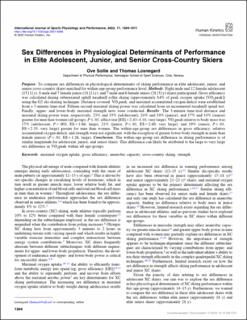| dc.description | This is an Open Access article distributed under the terms of the Creative Commons Attribution 4.0 International License (https://creativecommons.org/licenses/BY/4.0/), allowing third parties to copy and redistribute the material in any medium or format and to remix, transform, and build upon the material for any purpose, even commercially, provided the original work is properly cited and states its license. | en_US |
| dc.description.abstract | Purpose: To compare sex differences in physiological determinants of skiing performance in elite adolescent, junior, and senior cross-country skiers matched for within-age-group performance level.
Methods: Eight male and 12 female adolescent (15 [1] y), 8 male and 7 female junior (18 [1] y), and 7 male and 6 female senior (28 [5] y) skiers participated. Gross efficiency was calculated during submaximal uphill treadmill roller skiing (approximately 84% of peak oxygen uptake [VO2peak]) using the G2 ski-skating technique. Distance covered, VO2peak, and maximal accumulated oxygen deficit were established from a 3-minute time-trial. Fifteen-second maximal skiing power was calculated from an incremental treadmill speed test. Finally, upper- and lower-body maximal strength tests were conducted.
Results: The 3-minute time-trial distance and maximal skiing power were, respectively, 23% and 15% (adolescent), 24% and 19% (junior), and 17% and 14% (senior) greater for men than women (all groups, P ≤ .01, effect size [ES] = 2.43–4.18; very large). VO2peak relative to body mass was 17% (adolescent, P = .002, ES = 1.66, large), 21% (junior, P < .01, ES = 2.60, very large), and 19% (senior, P < .01, ES = 2.35, very large) greater for men than women. The within-age-group sex differences in gross efficiency, relative accumulated oxygen deficit, and strength were not significant, with the exception of greater lower-body strength in male than female juniors (P = .01, ES = 1.26, large).
Conclusion: The within-age-group sex difference in skiing performance is of similar magnitude for adolescent, junior, and senior skiers. This difference can likely be attributed to the large to very large sex difference in VO2peak within all age-groups. | en_US |
